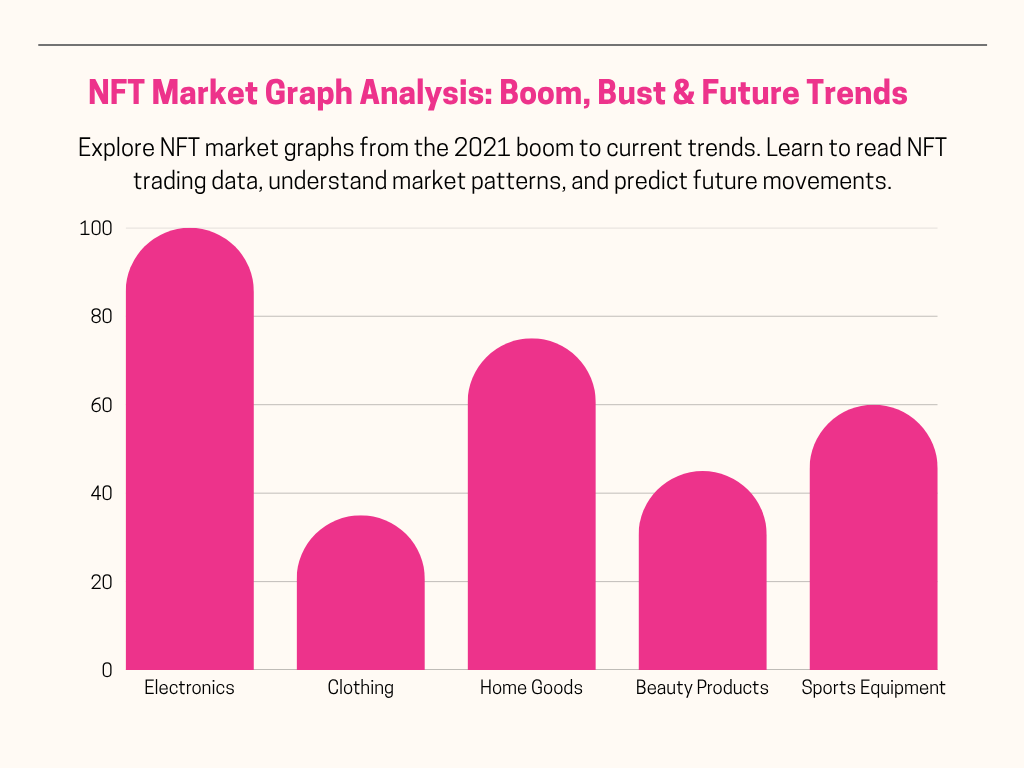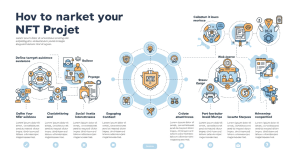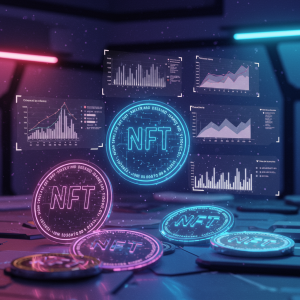NFT Market Graph: Understanding the Digital Asset Boom and Bust

The NFT market has experienced one of the most dramatic financial rollercoasters in recent history. From jaw-dropping million-dollar sales to devastating crashes, the non-fungible token space has captivated investors, artists, and skeptics alike. Understanding the market graphs and trends behind this digital phenomenon reveals crucial insights about speculative markets, digital ownership, and the future of blockchain technology.
This comprehensive analysis examines the NFT market’s trajectory through key data points, market graphs, and turning points that have shaped this emerging asset class.
The Meteoric Rise: 2020-2021 NFT Market Explosion
The NFT market graph tells a story of unprecedented growth that began in earnest during 2020. What started as a niche corner of the cryptocurrency world transformed into a multi-billion dollar market seemingly overnight.
Early Market Indicators
The foundation for the NFT boom was laid years before mainstream adoption. Crypto Kitties, launched in 2017, demonstrated the potential for digital collectibles on the blockchain. However, it wasn’t until 2020 that market graphs began showing consistent upward momentum.
Several factors contributed to this initial growth phase:
Digital Art Revolution: Artists discovered new monetization opportunities through tokenizing their work. Platforms like Super Rare and Foundation provided venues for creators to sell unique digital pieces.
Celebrity Endorsements: High-profile figures began purchasing and promoting NFTs, creating mainstream awareness and driving demand.
Pandemic-Driven Digital Adoption: With more people spending time online, digital assets gained increased acceptance and appeal.
The Peak: Early 2021 Market Surge
The NFT market graph reached its most dramatic peak in the first quarter of 2021. Trading volumes exploded from millions to billions of dollars within months. This surge was characterized by several landmark events that captured global attention.
The sale of Beeple’s “Everydays: The First 5000 Days” for $69.3 million at Christie’s auction house marked a watershed moment. This single transaction legitimized NFTs in traditional art circles and sent shockwaves through financial markets.
OpenSea, the largest NFT marketplace, saw trading volumes increase exponentially during this period. Monthly trading volumes that had previously measured in the tens of millions suddenly reached billions.
Market Dynamics and Trading Patterns
Understanding NFT market graphs requires examining the unique characteristics that differentiate this asset class from traditional investments.
Volatility and Speculation
NFT markets exhibit extreme volatility patterns that make traditional market analysis challenging. Unlike stocks or bonds, NFTs lack standardized valuation methods, leading to price discovery through pure market sentiment.

The speculative nature of NFT trading created bubble-like conditions. Many investors entered the market without understanding the underlying technology or long-term value propositions. This speculative fever contributed to unsustainable price increases across numerous NFT collections.
Collection-Based Trading
NFT market graphs reveal trading patterns organized around specific collections rather than individual assets. Projects like CryptoPunks, Bored Ape Yacht Club, and Art Blocks generated their own micro-economies within the broader NFT ecosystem.
These collections often experienced coordinated price movements, with floor prices (the lowest-priced items in a collection) serving as key indicators of overall collection health. Market graphs tracking floor prices became essential tools for NFT traders and investors.
The Great NFT Market Correction
The euphoria surrounding NFTs couldn’t last forever. Market graphs from mid-2021 onwards reveal a sobering correction that brought prices back to earth and forced a reassessment of the entire ecosystem.
Causes of the Decline
Multiple factors contributed to the NFT market’s downturn:
Market Saturation: The success of early NFT projects led to an explosion of new collections, diluting demand across an increasingly crowded marketplace.
Regulatory Uncertainty: Government agencies began scrutinizing NFTs, raising questions about their legal status and potential regulations.
Environmental Concerns: Criticism of blockchain technology’s energy consumption, particularly on Ethereum, created negative sentiment around NFT trading.
Economic Headwinds: Broader economic concerns, including inflation and recession fears, led investors to reduce exposure to speculative assets.
Impact on Different Market Segments
The correction affected various segments of the NFT market differently. Blue-chip collections like CryptoPunks maintained relatively stronger positions, while newer projects saw more dramatic declines.
Art-focused NFTs experienced significant value drops, with many pieces selling for fractions of their peak prices. Gaming and utility-focused NFTs showed more resilience, suggesting that practical applications might provide more sustainable value propositions.
Current Market Analysis and Trends
Recent NFT market graphs paint a picture of stabilization at significantly lower levels than peak periods. This normalization phase offers valuable insights into the market’s true underlying demand.
Volume and Value Metrics
Trading volumes have stabilized at levels well below peak activity but remain substantially higher than pre-boom periods. This suggests that while speculative excess has been eliminated, genuine interest in NFTs persists.
The average sale price of NFTs has also normalized, with most transactions occurring at much lower price points than during the height of the boom. This price correction has made NFTs more accessible to a broader range of participants.
Emerging Use Cases
Market graphs now reflect increased activity in practical NFT applications beyond speculative trading. Gaming NFTs, membership tokens, and utility-focused projects are showing more consistent trading patterns.
The integration of NFTs into established gaming platforms and social media networks suggests that utility-driven demand may provide more sustainable market foundations than purely speculative trading.
Technical Analysis of NFT Market Graphs
Reading NFT market graphs requires understanding unique metrics and indicators specific to this asset class.
Key Metrics to Track
Floor Price Movements: The lowest-priced items in popular collections serve as bellwethers for overall market sentiment.
Trading Volume: Daily and weekly trading volumes indicate market activity levels and liquidity.
Unique Buyers and Sellers: The number of distinct wallet addresses participating in trading reveals market participation breadth.
Market Capitalization: Total value of all NFTs provides a macro view of market size and trends.
Chart Patterns and Indicators
Traditional technical analysis tools have limited applicability to NFT markets due to their unique characteristics. However, some patterns have emerged:
Support and resistance levels often form around psychologically significant price points or historical transaction clusters. Volume spikes frequently coincide with major announcements or celebrity endorsements.
Moving averages can help identify trending directions, though the high volatility of NFT markets makes these indicators less reliable than in traditional asset classes.
Future Outlook and Market Predictions
The NFT market graph’s future trajectory remains uncertain, with several competing forces likely to influence its direction.
Positive Factors
Technology Improvements: Layer 2 solutions and more energy-efficient blockchains are addressing scalability and environmental concerns.
Institutional Adoption: Major corporations are exploring NFT applications for brand engagement and customer loyalty programs.
Regulatory Clarity: Clear regulatory frameworks could provide the certainty needed for broader institutional participation.
Potential Challenges
Market Maturation: As the market matures, explosive growth periods may become less frequent.
Competition: Alternative digital ownership models may emerge to challenge NFTs’ market position.
Economic Conditions: Broader economic downturns could continue to impact speculative asset classes like NFTs.
What NFT Market Graphs Teach Us About Digital Assets
The NFT market’s journey from obscurity to mainstream attention and back toward normalization offers valuable lessons for understanding digital asset markets.
The extreme volatility demonstrated in NFT market graphs highlights the challenges of valuing unique digital assets. Unlike fungible cryptocurrencies, each NFT’s value depends on subjective factors like artistic merit, rarity, and cultural significance.
The role of community and social proof in driving NFT values cannot be understated. Market graphs often show price movements that correlate more closely with social media buzz and influencer activity than traditional financial metrics.
The NFT market’s evolution suggests that sustainable growth in digital asset markets requires genuine utility beyond speculative trading. Projects that provide real value to users show more resilient price action in market graphs.
Understanding how to read and interpret NFT market graphs has become an essential skill for anyone interested in digital assets. These graphs tell the story of a revolutionary technology finding its place in the global financial ecosystem, complete with the growing pains and corrections that accompany any major innovation.
The future of NFTs will likely be determined by their ability to provide genuine value beyond speculative trading. Market graphs will continue to reflect this evolution, serving as a real-time indicator of the technology’s progress toward mainstream adoption and practical utility.
Meta data
Meta title
NFT Market Graph Analysis: Boom, Bust & Future Trends
Meta description
Explore NFT market graphs from the 2021 boom to current trends. Learn to read NFT trading data, understand market patterns, and predict future movements.








